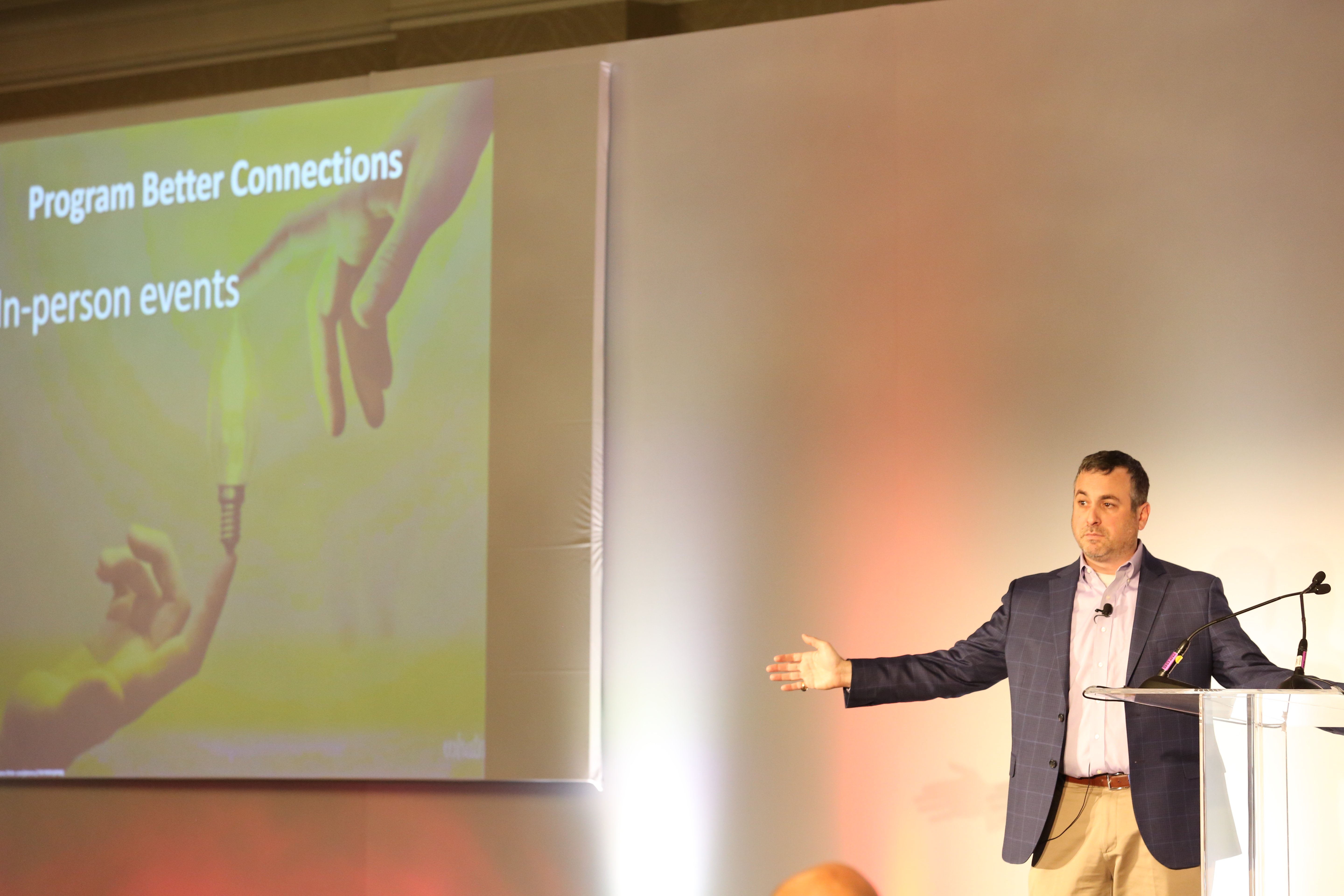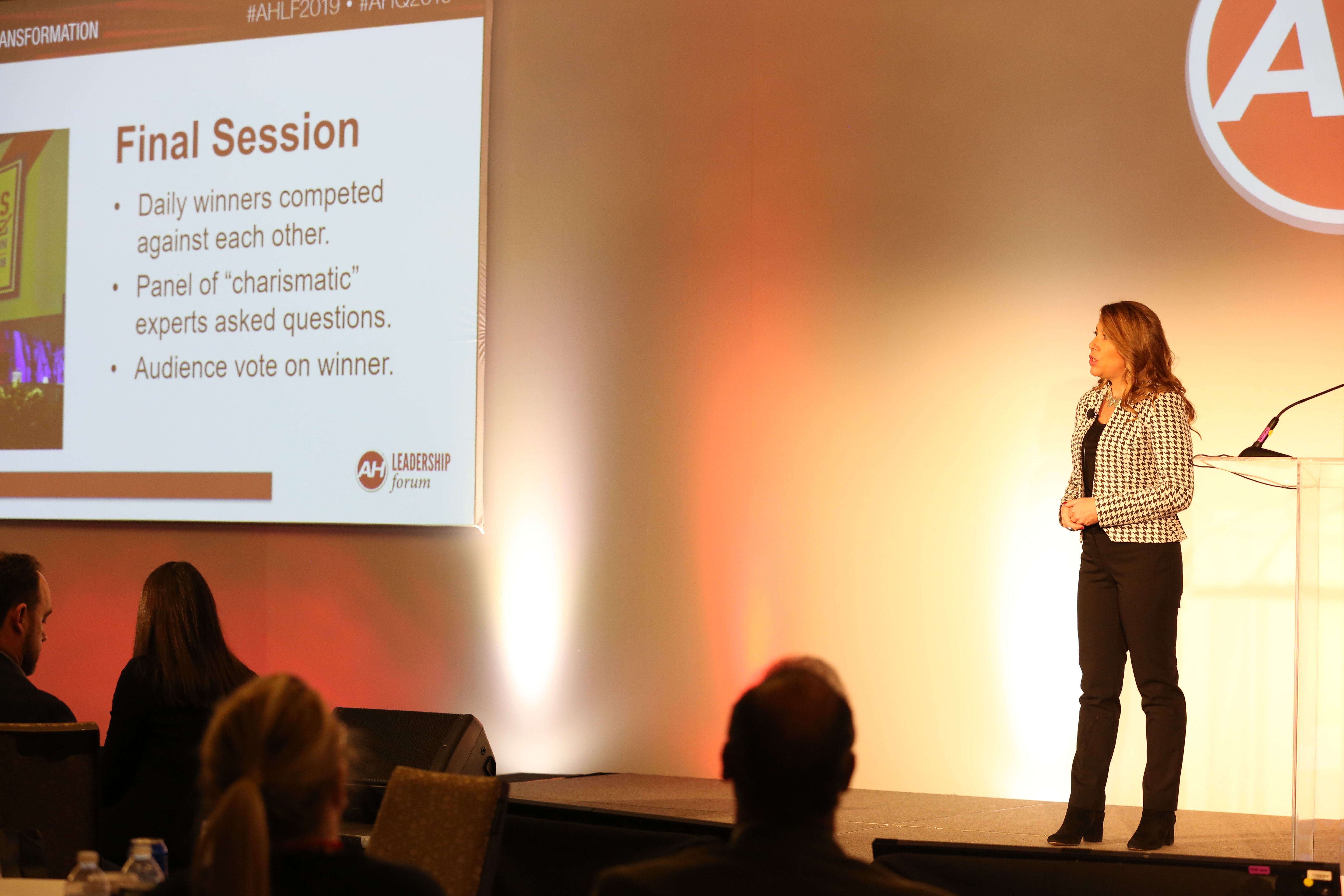Volunteer leaders from across the country gathered for inspiration, motivation, and practical tips for their associations
It’s a unique gathering of professionals. There are nurses, scientists, entrepreneurs, and artists gathered here. However different they may be, there’s one thing everyone in the room has in common: They are all volunteer leaders of their respective associations, managed by AH and here to learn how to be better communicators, board members, leaders, and advocates for their organizations. AH’s annual Leadership Forum is specially designed to support volunteers and their boards in solving the unique challenges associations face today.
Day 1: The Membership Challenge
Lowell Aplebaum, CAE, CPF, kicked off the 2019 Leadership Forum with his session, “Member Retention: Creating the Member Experience.” Associations provide a sense of belonging, according to Aplebaum, but membership is often treated as a transaction, focused on renewing dues, paying registration fees, or buying continuing education products. Aplebaum asked attendees to consider what makes members feel like they belong in their associations, and presented a challenge: If you could volunteer anywhere tomorrow, where would you volunteer and why? Responses included civic organizations, hospitals, and those serving families with sick children. The connection: all the attendees’ responses were aligned with their personal passions, and while they couldn’t recite the organizations’ mission statements, they were able to articulate what the organizations do and why that matters to them. The exercise showcased that associations exist to bring people together around things they care about, and as long as members understand why your association matters, they’ll find value in belonging.

But volunteer leaders’ jobs don’t stop at creating a sense of belonging. The real work starts when you focus on creating value. Aplebaum noted associations’ propensity to focus on providing solutions to problems, but the experience members have while utilizing those solutions is just as essential. From meetings to education and networking opportunities, simply creating the solution isn’t enough. Association leaders need to carefully consider the experience they want members to have and ensure that they deliver an experience that members will continue coming back for.

A critical area for associations today is the use of technology. Kate Dodd and Michael Candela of Community Brands presented a study that explored the evolution of technology in professional membership organizations and the expectations regarding technology. Indeed, technology often makes or breaks the membership experience. Dodd reviewed some key findings from the study, including the disparity between association professionals’ and members’ opinions of their associations’ overall use of technology. While 30% of members say their association’s use of technology is excellent, just 7% of professionals agreed. Dodd noted that association professionals are likely hard on themselves, but it warrants a closer look at what associations could be doing better.

The study was also an opportunity to assess how associations perform by technology type. Dodd focused specifically on event registration, saying that 66% of members rate their experience with association technology highly, but that approval starts to fall off when it comes to event registration. The lowest-rated technology: mobile apps. Apps proliferate around conference time, providing a useful platform to help meeting attendees plan sessions and find important information. Dodd argues for keeping apps around after a meeting, creating a year-round tool for networking, paying dues, and engagement.
Candela furthered the discussion, going beyond technology to discuss personalization. He noted that 60% of members feel “extremely connected” after receiving personalized content. His question to the volunteer leaders in attendance: How are you providing personalized content to your members? Specifically, he noted that associations that collect personalized information (e.g., areas of interest, specializations, or chapter memberships) and don’t use it to personalize their communications with members are increasingly being perceived as spammers.
Day 1 concluded with a rapid-fire presentation by AH staff showcasing how their associations leveraged new technologies, meeting formats, and education delivery tactics to improve the member experience. Jen Pastore, executive director of the National Association of Productivity and Organizing Professionals (NAPO), highlighted a visual pathway NAPO developed to help members seeking certification outline their path to advance. Megan Ramirez, marketing director for the Wound, Ostomy and Continence Nurses Society™ (WOCN®), discussed the organization’s successful roll-out of podcasts. She highlighted the benefits of the relatively inexpensive platform as an education delivery tool, specifically the personal touch of hearing the “voice” of an organization and the on-demand nature of podcasts providing members education on their schedule.

Michele Buggy, executive director of the International Energy Credit Association (IECA), showcased the association’s implementation of microlearning options via CREDTalks, a TEDTalk-style presentation that offers a 5-minute deep dive on a topic of interest with a call-to-action at the end directing viewers where to go to learn more. Dan Lemyre, executive director of the Society For Biomaterials (SFB) presented a case study of how the association recognized that a barrier to attendance at SFB’s annual meeting was a need to present research; if a researcher wasn’t selected to present their research at the meeting, they couldn’t get approval to attend. SFB changed that by implementing a rapid-fire format that allowed for 15 presentations in a single 90-minute session, which translated into an immediate increase in meeting registrations.
Melanie Ryan, meeting, exhibit and sponsorship relationship manager for the American Transplant Congress (ATC), presented a new sponsorship option implemented at the latest ATC meeting: a private meeting space on the show floor that made one-on-one engagement possible amidst the hustle and bustle of exhibit halls. Shannon Fagan, director of meetings and exhibits for ATC, discussed another new idea implemented at the meeting that drove engagement via a gamification element: the People’s Choice Awards. The awards allowed attendees to vote on a “best in show” session as a new way to recognize science and incorporate new abstracts into the program.

And, in the spirit of gamification, MaryBeth Kurland, chief executive officer of the Commission for Case Manager Certification (CCMC), presented on how CCMC was able to extend learning beyond the session room at the organization’s annual meeting. An online live-action quiz format allowed users to create unique handles, present questions, and engage with other attendees in a dialogue around topics and questions.
The membership-focused programming on day 1 of Leadership Forum left attendees inspired to identify how they can bring more value to the membership experience and with practical suggestions for tactics that they can implement at their next meeting.
Stay tuned for part 2!
Do you have any questions about the topics presented above? Feel free to get in touch with us and we are happy to discuss! email us: inquire@ahint.com




